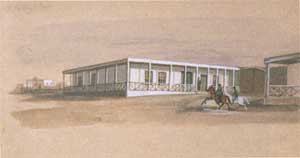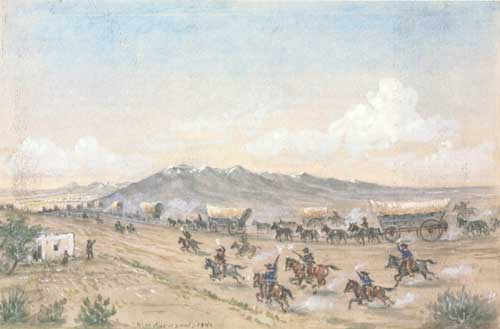
INTRODUCTION
By Marian Albright Schenk
FOREWORD
By Dean Knudsen
SECTION 1
Primary Themes of Jackson's Art
SECTION 2
Paintings of the Oregon Trail
SECTION 3
Historic Scenes From the West
 |
| William Henry Jackson had a way of surrounding himself with distinguished friends. A note on the back of this photograph identifies the two men simply as "Henry and Bill;" "Henry" is none other than Henry Ford. (SCBL 3029) |

Section 3: Historic Scenes from the West
THE SANTA FE TRAIL
In addition to the Oregon and California Trails, there was another major overland route known as the Santa Fe Trail. Although a few pioneers did make their way west on this road, the Santa Fe Trail was primarily devoted to commerce. In the early Nineteenth century several enterprising American businessmen tried to open up trade with the Spanish Southwest. Unfortunately, the Spanish were suspicious of the Americans' motives and laws were passed which forbid Spanish citizens from doing business with Americans.
Over the years, American fur trappers, traders, and explorers occasionally ventured into Spanish territory. During these visits they noticed an ample supply of silver and furs as well as a lack of manufactured goods. Reports of this potential market for American goods soon made their way back to the United States, however, several individuals who attempted to capitalize on this situation quickly found themselves in Spanish jails.
In 1821, an American desperately in need of money by the name of William Becknell decided to try again. He loaded several pack mules with tools, pots and pans, and linens and hauled them the 900 miles from Missouri to Santa Fe. Becknell was very lucky. By the time he arrived in Santa Fe on November 16, 1821, Mexico had succeeded in achieving its independence from Spain, so instead of becoming a prisoner he became a wealthy man.1
 |
| This neatly executed watercolor depicts Santa Fe in 1877. Such drawings were all Jackson had to show for that year, as he experimented with a new process and all 400 photographs made that season failed to turn out. (SCBL 106) |
Becknell's success signalled the opening of an important trade route that was used for the next fifty years. Almost overnight, a virtually endless stream of freight wagons were winding their way across the plains of Kansas and New Mexico. In the intervening years, the trailhead moved several times. First it was located in Franklin, Missouri. Then it moved to Independence, Missouri, until with the burgeoning riverboat trade it was eventually moved to Westport Landing—later known as Kansas City.
Unlike the Oregon Trail, which was made up of a mind-boggling network of intertwined cutoffs and shortcuts, the Santa Fe Trail was a relatively simple trail with only two major cutoffs. These consisted of the Mountain Branch, which veered west into Colorado before dropping down into New Mexico; and the Cimarron Cutoff, which angled down through the panhandle of Oklahoma before rejoining with the Mountain Branch.
Like the Oregon Trail, the Santa Fe Trail was eventually replaced by railroads, which were introduced to the plains of Kansas. By 1867, steam locomotives made the old trail east of Larned, Kansas, obsolete. By 1880 the railroads had taken over virtually all commercial traffic in the American Southwest.
William Henry Jackson's painting, "Los Americanos, depicts the arrival of William Becknell in Santa Fe in 1821—an event that took place twenty-two years before his own birth. While Jackson was obviously more interested in the California, Mormon, and Oregon Trails—since he experienced them firsthand, he was fully aware of the role the Santa Fe Trail played in America's westward expansion and did not want anyone to forget it.
1. Gregory M. Franzwa, Maps of the Santa Fe Trail (St. Louis: The Patrice Press, 1989), 1.
 |
| Los Americanos. Signed and date 1941. 25.4 x 38.1 cm. (SCBL 155) |
 |
scbl/knudsen/sec3i.htm Last Updated: 14-Apr-2006 |
 |